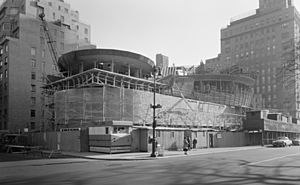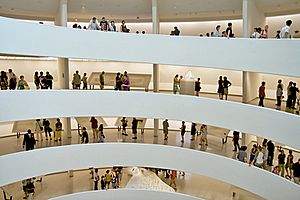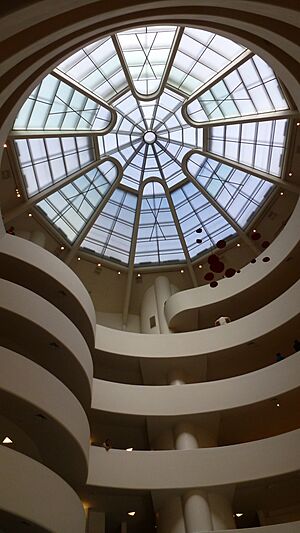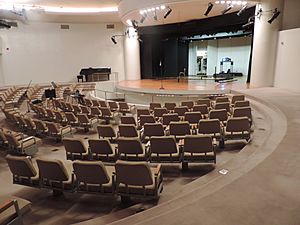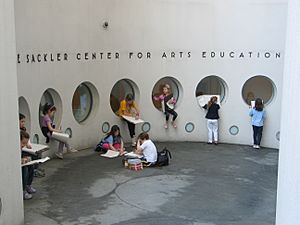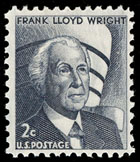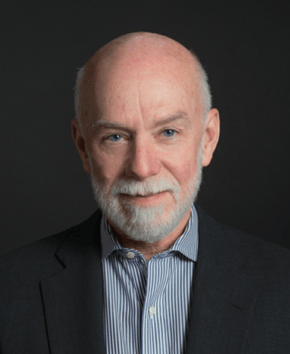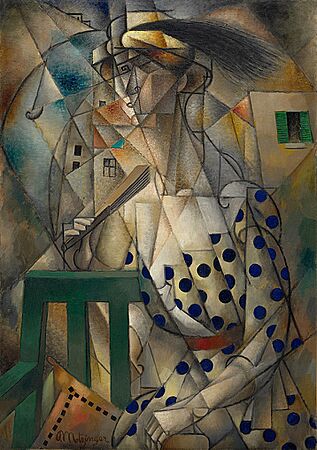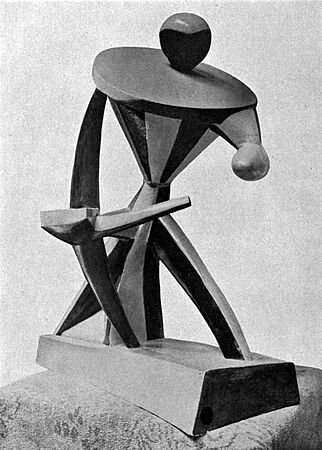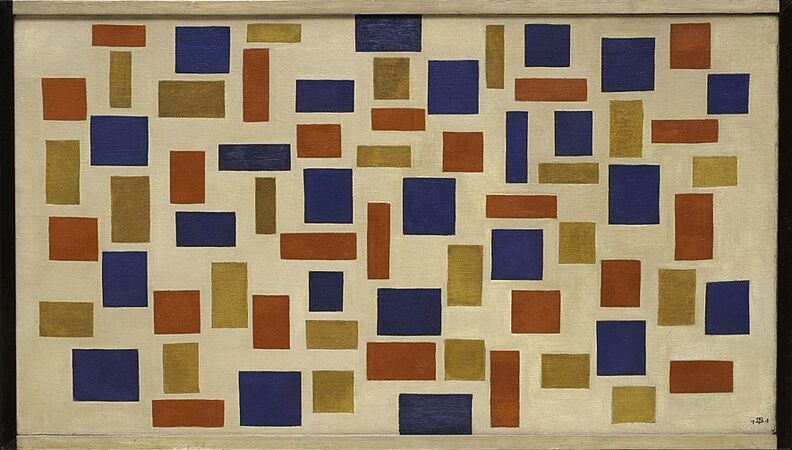Solomon R facts for kids

from Fifth Avenue
|
|
| Lua error in Module:Location_map at line 420: attempt to index field 'wikibase' (a nil value). | |
| Established | 1937 |
|---|---|
| Location | 1071 Fifth Avenue at 89th Street Manhattan, New York City |
| Type | Art museum |
| Visitors | 1,199,123 (2013) Ranked 51st globally (2013) |
| Public transit access | 86th Street (IRT Lexington Avenue Line) |
The Solomon R. Guggenheim Museum, often called The Guggenheim, is a famous art museum. It is located at 1071 Fifth Avenue in Manhattan, New York City. The museum is home to a growing collection of Impressionist, Post-Impressionist, early Modern, and contemporary art. It also hosts special art shows all year long.
The museum was started in 1939 by the Solomon R. Guggenheim Foundation. It was first known as the Museum of Non-Objective Painting. This was under the guidance of its first director, artist Hilla von Rebay. After its founder, Solomon R. Guggenheim, passed away in 1952, it got its current name.
In 1959, the museum moved into its unique building. This building is a famous example of 20th-century architecture. It was designed by Frank Lloyd Wright. The building is shaped like a cylinder, wider at the top than the bottom. It was meant to be a "temple of the spirit." Inside, a long, continuous ramp spirals up from the ground floor. This ramp goes along the outer edges of the building and ends under a skylight. The building was expanded and renovated in 1992, when a new tower was added. More work was done from 2005 to 2008.
The museum's art collection has grown over more than 80 years. It started with Solomon R. Guggenheim's own collection. This collection is shared with other Guggenheim museums, like the one in Bilbao, Spain. In 2013, almost 1.2 million people visited the museum. It even had the most popular art show in New York City that year.
Contents
History of the Guggenheim Museum
How the Museum Started
Solomon R. Guggenheim came from a rich mining family. He had been collecting old master paintings since the 1890s. In 1926, he met artist Hilla von Rebay. She showed him avant-garde art from Europe, especially abstract art. She believed this art had a spiritual side. Guggenheim then changed his focus and began collecting abstract art, including works by Wassily Kandinsky.
He started showing his collection to the public at his apartment in the Plaza Hotel in New York City. As his collection grew, he created the Solomon R. Guggenheim Foundation in 1937. Its goal was to help people appreciate modern art.
The Museum of Non-Objective Painting
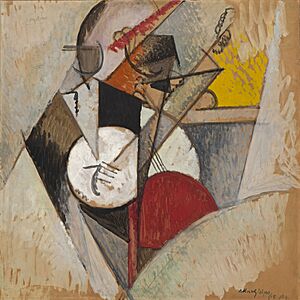
The foundation's first art space, the "Museum of Non-Objective Painting," opened in 1939. It was in midtown Manhattan and directed by Hilla von Rebay. Under Rebay's guidance, Guggenheim wanted to collect the most important non-objective art. This included works by early modern artists like Rudolf Bauer, Rebay, Kandinsky, Piet Mondrian, Marc Chagall, and Pablo Picasso.
By the early 1940s, the foundation had a huge collection of modern art. It became clear they needed a permanent museum building. In 1943, Rebay and Guggenheim asked Frank Lloyd Wright to design it. Wright agreed, excited to try his unique style in a city. It took him 15 years, 700 sketches, and many drawings to create the museum.
In 1948, the collection grew much larger. They bought about 730 art pieces from art dealer Karl Nierendorf's estate. This included many German expressionist paintings. By then, the foundation had a wide range of expressionist and surrealist works. These included paintings by Paul Klee, Oskar Kokoschka, and Joan Miró. After Guggenheim died in 1949, his family members on the foundation's board disagreed with Rebay. She resigned as director in 1952. The museum was renamed the Solomon R. Guggenheim Museum in 1952.
The Museum's Special Design
Rebay imagined the museum as a "temple of the spirit." She wanted it to offer a new way to experience modern art. She told Wright that each masterpiece should be "organized into space." She wanted a "temple of spirit, a monument!" The building changed how museums were designed. It made it okay for architects to create very expressive and personal museum buildings.
From 1943 to 1944, Wright drew four different designs. Most of them had circular shapes and used a ramp that spiraled around the building. He had already tried this ramp design in a house he built for his son in Arizona. Wright's main idea was like an upside-down "ziggurat," which are ancient stepped towers.
His design was different from typical museums. Usually, visitors walk through many rooms and then have to walk back. Wright's plan was for guests to take an elevator to the top. Then, they would slowly walk down the gentle spiral ramp. They would see the building's open center as their final piece of art. This open space let people see art on different levels at the same time. They could even see and interact with other visitors on different floors.
Wright, Rebay, and Guggenheim looked at many places in Manhattan for the museum. They finally chose the spot at 89th Street and Fifth Avenue. It overlooks Central Park. Guggenheim felt it was important to be near the park. The park offered a break from the city's noise and concrete. Nature also inspired the museum's design. The building shows Wright's goal to make natural, flowing shapes in architecture. The Guggenheim was the only museum Wright ever designed. Its city location meant Wright had to design it vertically, unlike his earlier, horizontal buildings.
The spiral shape reminded him of a nautilus shell. It has continuous spaces that flow into each other. Wright's design also showed his take on modern architecture's strict geometry. He gave symbolic meaning to the building's shapes. He said, "the circle, infinity; the triangle, structural unity; the spiral, organic progress; the square, integrity." Shapes repeat throughout the building. For example, oval columns match the fountain's shape. Circles are a main theme, from the rotunda to the floor designs.
The building's outside was made of concrete to save money. Wright had wanted a stone finish and a red exterior, but these ideas were not used. The smaller round building next to the main rotunda was meant for apartments. Instead, it became offices and storage. In 1965, it was renovated to show more art. In 1990–92, it became exhibition space and was named the Thannhauser Building. This was to honor a major gift of art to the museum. Wright's original plan for an attached tower, studios, and apartments was not built until later renovations. Also, the main skylight was covered during the original construction. This changed Wright's lighting effects. It was restored to its original design in 1992.
Building Completion and New Art
In 1953, the foundation's art collecting changed under its new director, James Johnson Sweeney. Sweeney started collecting "objective" paintings and sculptures. He bought Constantin Brâncuși's Adam and Eve (1921). He also acquired works by other modern sculptors like Jean Arp and Alexander Calder. Sweeney even bought art from before the 20th century, like Paul Cézanne's Man with Crossed Arms (c. 1899).
That same year, the foundation received 28 important artworks. These were a gift from the estate of Katherine Sophie Dreier. She had helped start America's first modern art museum, the Société Anonyme. These works included a sculpture by Brâncuși, a still life by Juan Gris, and collages by Kurt Schwitters. It also had works by Calder, Marcel Duchamp, and Piet Mondrian. Sweeney also bought works by Willem de Kooning and Jackson Pollock.
Sweeney oversaw the last six years of the museum's construction. He had some disagreements with Frank Lloyd Wright, especially about the building's lighting. The unique cylindrical building was Wright's last major work. He passed away six months before it opened. From the street, the building looks like a white ribbon curled into a stack. It is wider at the top than the bottom, with almost all curved surfaces. Its look is very different from the rectangular buildings around it in Manhattan. Wright liked this, saying his museum would make the nearby Metropolitan Museum of Art "look like a Protestant barn." Inside, the viewing gallery is a spiral ramp. It climbs gently from the ground floor to the skylight at the top.
Opening and Early Reactions
Even before it opened, the museum's design caused strong opinions among architecture critics. Some thought the building would be more noticeable than the art inside. Wright disagreed, saying the design made "the building and the painting an uninterrupted, beautiful symphony." Other critics and many artists felt it was hard to properly hang paintings in the shallow, curved spaces along the spiral. Twenty-one artists even signed a letter protesting how their work would be displayed.
On October 21, 1959, the museum opened its doors to large crowds. This was ten years after Solomon Guggenheim died and six months after Frank Lloyd Wright died. The building soon became widely praised and inspired many other architects.
Challenges and New Collections
Thomas M. Messer became the museum's director in 1961. He stayed for 27 years, the longest of any major New York art museum director. When Messer took over, people still wondered if the museum could properly show art. The continuous spiral ramp has tilted, curved walls, making it tricky. Paintings must be mounted away from the wall's surface. There is also limited space for sculptures.
In 1962, Messer took a risk. He put on a large show that combined the Guggenheim's paintings with sculptures from the Hirshhorn collection. Three-dimensional sculptures were especially challenging in the museum's unique space. Messer found a way to make it work. He built special stands at an angle so the sculptures looked straight, even though the floor was sloped.
The next year, Messer acquired a private collection from art dealer Justin K. Thannhauser. This added 73 works to the museum's permanent collection. These included Impressionist, Post-Impressionist, and French modern masterpieces. Important works by Paul Gauguin, Édouard Manet, Vincent van Gogh, and 32 works by Pablo Picasso were part of this gift.
Expanding the Collection and Building
Thomas Krens, who led the foundation from 1988 to 2008, greatly expanded the museum's collections. In 1991, he added the Panza Collection. This collection included Minimalist sculptures by artists like Carl Andre and Donald Judd. It also had Minimalist paintings and other modern art from the 1960s and 1970s. In 1992, the Robert Mapplethorpe Foundation gave 200 of his best photographs to the foundation. This started the foundation's photography exhibition program.
Also in 1992, the New York museum building was expanded. A new rectangular tower was added behind the original spiral. It is taller than the original building. This new tower was designed by the architectural firm Gwathmey Siegel & Associates Architects. They studied Wright's original drawings to design the 10-story limestone tower. It has four new exhibition galleries with flat walls, which are better for showing some types of art. The main gallery skylight, which had been covered, was also restored to Wright's original design in 1992.
To pay for these changes, the foundation sold some works by Kandinsky, Chagall, and Modigliani. This raised $47 million. Some people criticized this, but Krens said it helped expand the museum's international collection. He also worked to open more Guggenheim museums around the world. Krens was known for his business-like approach.
Under Krens, the museum held some of its most popular exhibitions. These included "Africa: The Art of a Continent" in 1996, "China: 5,000 Years" in 1998, and "The Aztec Empire" in 2004. It has also shown unusual exhibitions, like one on motorcycles. A 2009 show about Frank Lloyd Wright was the museum's most popular exhibit since 1992.
In 2001, the museum opened the Sackler Center for Arts Education. This 8,200 square foot facility offers classes and lectures about art. It also provides ways to interact with the museum's collections and special exhibitions. It has labs, exhibition spaces, and a 266-seat theater. It is located on the lower level of the museum. Also in 2001, the foundation received a large collection from the Bohen Foundation. This collection focused on film, video, photography, and new media.
Restoring the Outside of the Building
Between September 2005 and July 2008, the Guggenheim Museum's outside was greatly restored. Workers fixed cracks and updated systems and details. First, a team of experts studied the building's condition. They found the structure was strong. This study included:
- Removing paint to find hundreds of cracks. These were caused by temperature changes over the years.
- Watching how some cracks moved for 17 months.
- Using sound waves to find empty spaces inside the walls.
- Using lasers to map the outside and inside surfaces. This was one of the largest laser models ever made.
- Taking samples of the original concrete and building materials.
- Testing materials to use for repairs.
Much of the building's inside was restored in 1992. The 2005–2008 restoration mainly focused on the outside of the original building and its systems. This included the skylights, windows, doors, concrete walls, and sidewalks. It also updated the climate control system. The goal was to keep as much of the museum's original look as possible. At the same time, they made necessary repairs and created a good environment for the museum to keep showing art.
On September 22, 2008, the Guggenheim celebrated the end of the three-year restoration. New York City Mayor Michael R. Bloomberg led the celebration. Artist Jenny Holzer created a special light artwork called For the Guggenheim to honor Peter B. Lewis, a major supporter of the restoration. The museum was recognized as a National Historic Landmark on October 6, 2008.
Recent Years
In 2005, Thomas Krens had a disagreement with Peter B. Lewis, a major supporter. Lewis left the Board because he disagreed with Krens' plans to open more Guggenheim museums around the world. Also in 2005, Lisa Dennison became the director of the Solomon R. Guggenheim Museum in New York. She resigned in July 2007.
Tensions between Krens and the Board continued. In February 2008, Krens stepped down as the foundation's director. He still works as an advisor for international affairs.
Richard Armstrong became the museum's fifth director on November 4, 2008. He had been the director of the Carnegie Museum of Art in Pittsburgh, Pennsylvania, for 12 years. The museum's Chief Curator and Deputy Director is Nancy Spector.
Besides its permanent collections, which keep growing, the foundation also organizes traveling art shows. It works with other museums to reach more people. In 2013, almost 1.2 million people visited the museum. It hosted the most popular exhibition in New York City that year, featuring artist James Turrell.
Art in the Collection
-
Franz Marc, 1911, The Yellow Cow
-
Alexander Archipenko, 1913, Pierrot-carrousel
-
Theo van Doesburg, 1918, Composition XI
-
Paul Klee, 1922, Red Balloon
In Popular Culture
In the movie The International, a shootout happens inside the museum. A life-size copy of the museum was built just for this scene!



